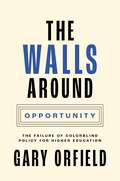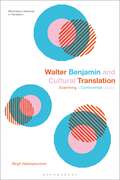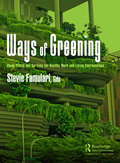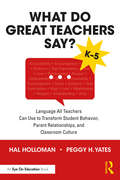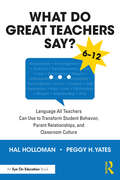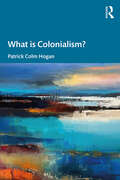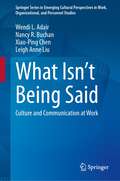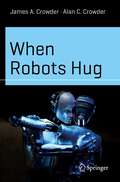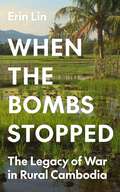- Table View
- List View
Voices of Intimate Partner Homicide: An Exploration of Coercive Control and Lethality
by Donna J. KingIn the United States and most parts of the world, law, policy, policing, and prevention work addressing domestic and intimate partner violence is created and enacted based on a violence model. Likewise, it is generally believed that all victims of intimate partner homicide are victims of intimate partner violence, through physical abuse, prior to the incident of homicide, and that this violence is reported beforehand.Voices of Intimate Partner Homicide takes a critical look at these misconceived notions and sheds light on multiple non-violent forms of controlling behavior that precipitate intimate partner homicide. The book bases its critical examination on a content analysis of court-filed Petitions for Injunction for Protection Against Domestic Violence. Through these records, as well as corresponding police and homicide reports, the accounts of the victims, and their relationships with their offenders, come to life. Recurring coercive control tactics are coded and analyzed across multiple accounts, including intimidation, isolation, and humiliation, to illustrate the ways in which individuals are threatened prior to homicide and the true extent of harm that happens in the absence of physical violence. Considering the victim’s responses, as well as their interaction with law enforcement and the court system prior to their death, the author challenges current legal and policy initiatives made to address and protect victims from intimate partner violence and argues that non-violent controlling behaviors deserve more attention in lethality risk assessments that are utilized throughout the United States.For practitioners, advocates, researchers, and students, this book provides an intimate and important account of the causes and consequences of intimate partner violence prior to homicide and a rare window into the victim’s overall experience.
Von Japan nach Deutschland: Eine Studie zur Integration von Japanerinnen und Japanern in deutschen Großstädten (Studien zur Migrations- und Integrationspolitik)
by Vanessa TkotzykIn diesem Open-Access-Buch wird erstmals mithilfe einer qualitativen Studie in den fünf größten japanischen Communitys Deutschlands - Düsseldorf, München, Berlin, Frankfurt am Main, Hamburg - das Migrations- und Eingliederungsverhalten dauerhaft ansässiger Japanerinnen und Japaner in Deutschland untersucht. Die Zahlen belegen, dass es sich bei den japanischen Migrantinnen und Migranten um eine kleine Gruppe handelt. Dennoch übt sie einen prägenden Einfluss auf die Wirtschaft und die Infrastruktur in den jeweiligen Städten aus, worauf auch die Tätigkeiten verschiedener Vereine sowie eine öffentliche Präsenz dieser Gruppe in der Presse, in Broschüren und im Internet hinweisen. Vor dem Hintergrund der Globalisierung wird es immer dringender, Migration zwischen wohlhabenden Ländern sowie die Eingliederung der von dort kommenden Personen zu betrachten. Vanessa Tkotzyk zeigt anhand der permanent ansässigen Japanerinnen und Japaner, dass nicht mehr nur Expatriates und ihre Familien nach Deutschland auswandern, sondern auch solche außerhalb des Firmenkontextes und dass japanische Migrantinnen und Migranten hochinteressante Merkmale für die Migrations- und Integrationsforschung aufweisen. Dies kann eine nähere Betrachtung der Entwicklung von Integrationskonzepten ermöglichen, die eine größere Diversität von Migrantinnen und Migranten berücksichtigen.
Wahlen und Wähler: Analysen zur Bundestagswahl 2021
by Harald Schoen Bernhard WeßelsDer Band bündelt Analysen führender Wahlforscherinnen und Wahlforscher sowie Politikwissenschaftlerinnen und Politikwissenschaftler aus Deutschland zur Bundestagswahl 2021. Der Band ist die Fortsetzung der sogenannten „Blauen Bände“, die seit ihrem Beginn 1980 umfassend und systematisch Analysen zu allen Bundestagswahlen und zu international relevanten Ergebnissen der Wahlforschung zusammenfasst.
The Walls around Opportunity: The Failure of Colorblind Policy for Higher Education (Our Compelling Interests #8)
by Gary OrfieldThe case for race-conscious education policyIn our unequal society, families of color fully share the dream of college but their children often attend schools that do not prepare them, and the higher education system gives the best opportunities to the most privileged. Students of color hope for college but often face a dead end.For many young people, racial inequality puts them at a disadvantage from early childhood. The Walls around Opportunity argues that colorblind policies have made college inaccessible to a large share of students of color, and reveals how policies that acknowledge racial inequalities and set racial equality goals can succeed where colorblindness has failed.Gary Orfield paints a troubling portrait of American higher education, explaining how profound racial gaps imbedded in virtually every stage of our children&’s lives pose a major threat to communities of color and the nation. He describes how the 1960s and early 1970s was the only period in history to witness sustained efforts at racial equity in higher education, and how the Reagan era ushered in today&’s colorblind policies, which ignore the realities of color inequality. Orfield shows how this misguided policy has resegregated public schools, exacerbated inequalities in college preparation, denied needed financial aid to families, and led to huge price increases over decades that have seen little real gain in income for most Americans.Now with a new afterword that discusses the 2023 Supreme Court decision to outlaw affirmative action in college admissions, this timely and urgent book shows that the court&’s colorblind ruling is unworkable in a society where every aspect of opportunity and preparation is linked to race, and reveals the gaps in the opportunity pipeline while exploring the best ways to address them in light of this decision.
Walter Benjamin and Cultural Translation: Examining a Controversial Legacy (Bloomsbury Advances in Translation)
by Birgit HaberpeuntnerDissecting the radical impact of Walter Benjamin on contemporary cultural, postcolonial and translation theory, this book investigates the translation and reception of Benjamin's most famous text about translation, “The Task of the Translator,” in English language debates around 'cultural translation'. For years now, there has been a pronounced interest in translation throughout the Humanities, which has come with an increasing detachment of translation from linguistic-textual parameters. It has generated a broad spectrum of discussions subsumed under the heading of 'cultural translation', a concept that is constantly re-invented and manifests in often heavily diverging expressions. However, there seems to be a distinct constant: In their own (re-)formulations of this concept, a remarkable number of scholars-Bhabha, Chow, Niranjana, to name but a few-explicitly refer to Walter Benjamin's “The Task of the Translator.” In its first part, this book considers Benjamin and the way in which he thought about, theorized and practiced translation throughout his writings. In a second part, Walter Benjamin meets 'cultural translation': tracing various paths of translation and reception, this part also tackles the issues and debates that result from the omnipresence of Walter Benjamin in contemporary theories and discussions of 'cultural translation'. The result is a clearer picture of the translation and reception processes that have generated the immense impact of Benjamin on contemporary cultural theory, as well as new perspectives for a way of reading that re-shapes the canonized texts themselves and holds the potential of disturbing, shifting and enriching their more 'traditional' readings.
Ways of Greening: Using Plants and Gardens for Healthy Work and Living Surroundings
by Stevie FamulariThis book focuses on rethinking working and living spaces and understanding how "greening" can make them healthier and their occupants happier. It teaches how to see unique ideas for spaces and some of the materials needed to create the designs. Inspired by a study that states that 8% of a space needs to have plants in order to positively affect the air quality of the space, this book explores what that minimum would look like in spaces and how it can be done to existing spaces as well as to new site designs, greening both interiors and exteriors. Using the mathematical amount of 10% per square foot, the illustrations start at that quantity of greening and show how it can look. The sites selected are both public and private sites, as well as interior and exterior. As there are more modalities, needs, and locations where people now work, making sure that multiple types of spaces are designed for people’s success is more relevant than ever. This includes designs for more traditional offices, open-air offices, commercial spaces, homes, studios, and more. Ways of Greening: using Plans and Gardens for Healthy Work and Living Surroundings gives readers a way to not only understand greening but to understand how to see greening applied to their place. The two basic ways to see the spaces selected are existing spaces to which greening design is applied afterward and upcoming spaces in which greening design can be built directly into the space. The first type of retrofitting greening into existing spaces can also be combined with the second type of space (new designs). There are examples of both types throughout the book. Essentially, this book addresses ways in which business owners, residents, developers, architects, agencies, and others can integrate greening to improve the air quality and the quality of life with a green solution.
Ways of Greening: Using Plants and Gardens for Healthy Work and Living Surroundings
by Stevie FamulariThis book focuses on rethinking working and living spaces and understanding how "greening" can make them healthier and their occupants happier. It teaches how to see unique ideas for spaces and some of the materials needed to create the designs. Inspired by a study that states that 8% of a space needs to have plants in order to positively affect the air quality of the space, this book explores what that minimum would look like in spaces and how it can be done to existing spaces as well as to new site designs, greening both interiors and exteriors. Using the mathematical amount of 10% per square foot, the illustrations start at that quantity of greening and show how it can look. The sites selected are both public and private sites, as well as interior and exterior. As there are more modalities, needs, and locations where people now work, making sure that multiple types of spaces are designed for people’s success is more relevant than ever. This includes designs for more traditional offices, open-air offices, commercial spaces, homes, studios, and more. Ways of Greening: using Plans and Gardens for Healthy Work and Living Surroundings gives readers a way to not only understand greening but to understand how to see greening applied to their place. The two basic ways to see the spaces selected are existing spaces to which greening design is applied afterward and upcoming spaces in which greening design can be built directly into the space. The first type of retrofitting greening into existing spaces can also be combined with the second type of space (new designs). There are examples of both types throughout the book. Essentially, this book addresses ways in which business owners, residents, developers, architects, agencies, and others can integrate greening to improve the air quality and the quality of life with a green solution.
We Are the Evidence: A Handbook for Finding Your Way After Sexual Assault
by Cheyenne WilsonA necessary, reassuring guide for all sexual assault survivors in need of immediate emotional and legal support post assault, and in the months and years after.We Are the Evidence is the first comprehensive resource for survivors of sexual assault. Written with conviction and compassion by Cheyenne Wilson, a registered nurse and survivor of sexual assault, this handbook contains everything victims and advocates need to know to navigate the tumultuous times that follow an assault. Within, there's advice for: The appropriate steps to take immediately after an assault Disclosing your assault how and when you choose How to pursue justice and navigate the legal system Beginning the healing process and reclaiming your power Throughout, you'll find exercises, opportunities to rest, and invaluable guidance from experts like attorneys, detectives and therapists. Voices from other sexual assault survivors also lend their support. Meant to be easily accessible, everything is organized for you to go right to the topic you most need guidance for, no matter where you are on your healing journey. You deserve to be heard, believed, and supported.
A Weberian Perspective on Home, Nature and Sport: Disenchantment and Salvation (ISSN)
by Michael SymondsThis book extends Max Weber’s theory of the value-spheres of modernity into wholly new areas, showing that the addition of home, nature and sport to Weber’s own list of five spheres (economic, scientific/intellectual, political/legal, erotic and aesthetic) yields original insights into these aspects of modernity and modernity itself. It shows how each of these new spheres is able to create its own ‘inner cosmos’ of salvation from rationalised senselessness, just as Weber’s ‘irrational’ spheres offer release from the grim reality of capitalism, the disenchanted universe and the bureaucratic state formed by the more ‘rationalised’ spheres. Drawing on a wide, cross-disciplinary range of sources, the author sheds light on the role of home in creating a sense of our enchanted past, of nature in helping to restore to the world a teleological meaning constructed from innocence and purity and of sport in imposing sense on the world, at least temporarily. A Weberian Perspective on Home, Nature and Sport: Disenchantment and Salvation will appeal to scholars of sociology and social theory with interests in classical sociological theory and the analysis of modernity.
A Weberian Perspective on Home, Nature and Sport: Disenchantment and Salvation (ISSN)
by Michael SymondsThis book extends Max Weber’s theory of the value-spheres of modernity into wholly new areas, showing that the addition of home, nature and sport to Weber’s own list of five spheres (economic, scientific/intellectual, political/legal, erotic and aesthetic) yields original insights into these aspects of modernity and modernity itself. It shows how each of these new spheres is able to create its own ‘inner cosmos’ of salvation from rationalised senselessness, just as Weber’s ‘irrational’ spheres offer release from the grim reality of capitalism, the disenchanted universe and the bureaucratic state formed by the more ‘rationalised’ spheres. Drawing on a wide, cross-disciplinary range of sources, the author sheds light on the role of home in creating a sense of our enchanted past, of nature in helping to restore to the world a teleological meaning constructed from innocence and purity and of sport in imposing sense on the world, at least temporarily. A Weberian Perspective on Home, Nature and Sport: Disenchantment and Salvation will appeal to scholars of sociology and social theory with interests in classical sociological theory and the analysis of modernity.
Wellbeing at Work: How to Design, Implement and Evaluate an Effective Strategy
by Ian Hesketh Cary CooperWith employee wellbeing at the forefront, Wellbeing at Work is the succinct and practical guide to designing and implementing an effective strategy that will help reduce workplace stress and improve overall performance.This book not only explains the reasons to consider employee mental health and wellbeing in the workplace but states why it is vital and draws from a people's approach on how to provide a clear framework to increase staff engagement. Updated by experts with the latest research, insightful approaches and key takeaways, this new edition illustrates how managers and leaders can introduce and maintain the right environment to reduce presenteeism and employee anxiety, as well as positively influence employees' overall wellbeing.Filled with advice and case studies pertaining to the effects of hybrid working, and how to effectively manage employees without jeopardizing their wellbeing, this second edition takes readers through the entire process of improving wellbeing at work.
Wellbeing at Work: How to Design, Implement and Evaluate an Effective Strategy
by Ian Hesketh Cary CooperWith employee wellbeing at the forefront, Wellbeing at Work is the succinct and practical guide to designing and implementing an effective strategy that will help reduce workplace stress and improve overall performance.This book not only explains the reasons to consider employee mental health and wellbeing in the workplace but states why it is vital and draws from a people's approach on how to provide a clear framework to increase staff engagement. Updated by experts with the latest research, insightful approaches and key takeaways, this new edition illustrates how managers and leaders can introduce and maintain the right environment to reduce presenteeism and employee anxiety, as well as positively influence employees' overall wellbeing.Filled with advice and case studies pertaining to the effects of hybrid working, and how to effectively manage employees without jeopardizing their wellbeing, this second edition takes readers through the entire process of improving wellbeing at work.
What Do Great Teachers Say?: Language All Teachers Can Use to Transform Student Behavior, Parent Relationships, and Classroom Culture K-5
by Hal Holloman Peggy H. YatesDo you remember a time when you used the right words at the right moment, and they made all the difference? With the aim of helping you repeat that experience every day, this book provides hundreds of examples of what we call Great Teacher Language, a technique designed to help all teachers use words to transform student behavior and parent relationships. In their years of working at the K-12 levels, educators Hal Holloman and Peggy H. Yates have identified the exact phrases and key words you can use in your classroom to address inappropriate outbursts, a lack of respect and cooperation, student conflict, and more. Great Teacher Language will enable you to transform student behavior, parent relationships, and your classroom culture. This book features 11 Great Teacher Language Word Categories, which you'll learn how to use in terms of self-talk, student talk, and parent talk: Words of Accountability, Words of Encouragement, Words of Grace, Words of Guidance, Words of High Expectations, Words of Hope, Words of Love, Words of Relationships, Words of Respect, Words of Understanding, and Words of Unity. Filled with helpful charts and Great Teacher Language examples, this resource will be one you turn to again and again, and will make a transformational difference for your students, your parents, and you!
What Do Great Teachers Say?: Language All Teachers Can Use to Transform Student Behavior, Parent Relationships, and Classroom Culture K-5
by Hal Holloman Peggy H. YatesDo you remember a time when you used the right words at the right moment, and they made all the difference? With the aim of helping you repeat that experience every day, this book provides hundreds of examples of what we call Great Teacher Language, a technique designed to help all teachers use words to transform student behavior and parent relationships. In their years of working at the K-12 levels, educators Hal Holloman and Peggy H. Yates have identified the exact phrases and key words you can use in your classroom to address inappropriate outbursts, a lack of respect and cooperation, student conflict, and more. Great Teacher Language will enable you to transform student behavior, parent relationships, and your classroom culture. This book features 11 Great Teacher Language Word Categories, which you'll learn how to use in terms of self-talk, student talk, and parent talk: Words of Accountability, Words of Encouragement, Words of Grace, Words of Guidance, Words of High Expectations, Words of Hope, Words of Love, Words of Relationships, Words of Respect, Words of Understanding, and Words of Unity. Filled with helpful charts and Great Teacher Language examples, this resource will be one you turn to again and again, and will make a transformational difference for your students, your parents, and you!
What Do Great Teachers Say?: Language All Teachers Can Use to Transform Student Behavior, Parent Relationships, and Classroom Culture 6-12
by Hal Holloman Peggy H. YatesDo you remember a time when you used the right words at the right moment, and they made all the difference? With the aim of helping you repeat that experience every day, this book provides hundreds of examples of what we call Great Teacher Language, a technique designed to help all teachers use words to transform student behavior and parent relationships. In their years of working at the K-12 levels, educators Hal Holloman and Peggy H. Yates have identified the exact phrases and key words you can use in your classroom to address inappropriate outbursts, a lack of respect and cooperation, student conflict, and more. Great Teacher Language will enable you to transform student behavior, parent relationships, and your classroom culture.The book features 11 Great Teacher Language Word Categories, which you'll learn how to use in terms of self-talk, student talk, and parent talk: Words of Accountability, Words of Encouragement, Words of Grace, Words of Guidance, Words of High Expectations, Words of Hope, Words of Love, Words of Relationships, Words of Respect, Words of Understanding, and Words of Unity.Filled with helpful charts and Great Teacher Language examples, this resource will be one you turn to again and again and will make a transformational difference for your middle and high school students, their parents, and you!
What Do Great Teachers Say?: Language All Teachers Can Use to Transform Student Behavior, Parent Relationships, and Classroom Culture 6-12
by Hal Holloman Peggy H. YatesDo you remember a time when you used the right words at the right moment, and they made all the difference? With the aim of helping you repeat that experience every day, this book provides hundreds of examples of what we call Great Teacher Language, a technique designed to help all teachers use words to transform student behavior and parent relationships. In their years of working at the K-12 levels, educators Hal Holloman and Peggy H. Yates have identified the exact phrases and key words you can use in your classroom to address inappropriate outbursts, a lack of respect and cooperation, student conflict, and more. Great Teacher Language will enable you to transform student behavior, parent relationships, and your classroom culture.The book features 11 Great Teacher Language Word Categories, which you'll learn how to use in terms of self-talk, student talk, and parent talk: Words of Accountability, Words of Encouragement, Words of Grace, Words of Guidance, Words of High Expectations, Words of Hope, Words of Love, Words of Relationships, Words of Respect, Words of Understanding, and Words of Unity.Filled with helpful charts and Great Teacher Language examples, this resource will be one you turn to again and again and will make a transformational difference for your middle and high school students, their parents, and you!
What is Colonialism?
by Patrick Colm HoganWhat is Colonialism? develops a clear and rigorous account of what colonialism is and how it works. It draws on and synthesizes recent work in cognitive science, affective science, and social psychology, along with Marxism and related forms of analysis. Hogan begins with some fundamental conceptual distinctions, such as the degree to which a group shares beliefs, dispositions, and skills versus the degree to which they share identification with a category. Building on these distinctions, he defines colonialism in terms of political, economic, and cultural autonomy, clarifying the nature of culture and autonomy particularly. He goes on to articulate an invaluable systematic account of the varieties of colonialism. The final chapters outline the motives of imperialists, differentiating these from their ideological rationalizations, and sketching the harms caused by colonialism. The book concludes by considering when, or if, one can achieve a genuinely postcolonial condition. Hogan illustrates these analyses by examining influential literary works—by European writers (such as Joseph Conrad) and by non-Europeans (such as Athol Fugard, Kamala Markandaya, and Wole Soyinka). This accessible and informative volume is the ideal resource for students and scholars interested in colonialism and empire.
What is Colonialism?
by Patrick Colm HoganWhat is Colonialism? develops a clear and rigorous account of what colonialism is and how it works. It draws on and synthesizes recent work in cognitive science, affective science, and social psychology, along with Marxism and related forms of analysis. Hogan begins with some fundamental conceptual distinctions, such as the degree to which a group shares beliefs, dispositions, and skills versus the degree to which they share identification with a category. Building on these distinctions, he defines colonialism in terms of political, economic, and cultural autonomy, clarifying the nature of culture and autonomy particularly. He goes on to articulate an invaluable systematic account of the varieties of colonialism. The final chapters outline the motives of imperialists, differentiating these from their ideological rationalizations, and sketching the harms caused by colonialism. The book concludes by considering when, or if, one can achieve a genuinely postcolonial condition. Hogan illustrates these analyses by examining influential literary works—by European writers (such as Joseph Conrad) and by non-Europeans (such as Athol Fugard, Kamala Markandaya, and Wole Soyinka). This accessible and informative volume is the ideal resource for students and scholars interested in colonialism and empire.
What is Political Sociology? (What is Sociology?)
by Elisabeth S. ClemensWith an entire discipline devoted to political science, what is distinctive about political sociology? This concise book explains what a sociological perspective brings to our understanding of the emergence, reproduction, and transformation of different forms of political order. Crucially, political sociology expands the field of view to the politics that happen in other social settings – in the family, at work, in civic associations – as well as the ways in which social attributes such as class, religion, age, race, and gender shape patterns of political participation and the distribution of political power.Political sociology grapples with these issues across an enormous range of historical and geographic settings, from intimate to geo-political scales. It requires an analytic toolkit that includes concepts of power, identities and inequalities, social closure, civil society, and modes of political action. Using these central concepts, this updated edition of What is Political Sociology? discusses the major forms of political order, processes of regime formation and revolution, the social bases for political participation, policy formation as well as feedbacks, social movements and social change, and the possibilities for new forms of digital and transnational politics. In sum, the book offers an insightful introduction to this core perspective on social life.
What is Sexualized Violence?: Intersectional Readings (Routledge Research in Gender and Society)
by Jana SchäferWhat is Sexualized Violence? Intersectional Readings uses an intersectional, queer, and subject-oriented approach to examine how societies constitute subjects as abilized and vulnerabilized with respect to sexualized violence. Contributing to our thinking about the dynamic relationship between social structure, subject formation, intersubjectivity, and violence, this text deploys an intersectional reading to engage with the complex social topography that both offers and imposes violence as a socially mediated practice. Instead of discussing one particular group at the intersection of race and gender, this book discusses the constitution of positionalities through systems of oppression and includes racialization, gender, sexuality, disability, and age. Moreover, the text is also interested in explicitly engaging with how the history of disciplines, institutions, and organizations contributed to the current constitution of opportunities for violence. It gives us modes of thinking to confront sexualized violence as a social problem and challenge the discourses and social structures that uphold it. This book is meant to offer questions and approaches for students and scholars, practitioners and policy makers, and survivors of sexualized violence who have an interest in an intersectional perspective on sexualized violence.
What is Sexualized Violence?: Intersectional Readings (Routledge Research in Gender and Society)
by Jana SchäferWhat is Sexualized Violence? Intersectional Readings uses an intersectional, queer, and subject-oriented approach to examine how societies constitute subjects as abilized and vulnerabilized with respect to sexualized violence. Contributing to our thinking about the dynamic relationship between social structure, subject formation, intersubjectivity, and violence, this text deploys an intersectional reading to engage with the complex social topography that both offers and imposes violence as a socially mediated practice. Instead of discussing one particular group at the intersection of race and gender, this book discusses the constitution of positionalities through systems of oppression and includes racialization, gender, sexuality, disability, and age. Moreover, the text is also interested in explicitly engaging with how the history of disciplines, institutions, and organizations contributed to the current constitution of opportunities for violence. It gives us modes of thinking to confront sexualized violence as a social problem and challenge the discourses and social structures that uphold it. This book is meant to offer questions and approaches for students and scholars, practitioners and policy makers, and survivors of sexualized violence who have an interest in an intersectional perspective on sexualized violence.
What Isn’t Being Said: Culture and Communication at Work (Springer Series in Emerging Cultural Perspectives in Work, Organizational, and Personnel Studies)
by Wendi L. Adair Nancy R. Buchan Xiao-Ping Chen Leigh Anne LiuThis book examines how exactly effective intercultural communication at work takes place. In order to do so, the authors take a deep dive into understanding the communication process and variation in communication patterns across cultures and individuals. They introduce a model that focuses on four sources of nonverbal communication, discuss existing research on intercultural communication in the workplace, and offer propositions for future research on the indirect, implicit, and nonverbal cues that can stymie cross-cultural communication effectiveness at work.
When Do People Obey Laws?: Towards an Integrated Approach to Compliance (International Law and Economics)
by Shubhangi RoyThis book examines the intricate dynamics of when individuals adhere to laws, taking into account the context in which laws attempt to shape human behavior. While existing literature touches upon various reasons why people comply with laws, the book focuses on a critical question which has been missing from the discussion: when do people obey laws? By treating law as a form of social communication, it develops an integrated framework to answer this question. It explores how social, psychological, and institutional conditions shape compliance decisions of individuals. What does a law signify? When does the compulsion to obey arise? When do individuals comply out of a fear for legal sanctions or social repercussions? Why do some laws have high symbolic values and others fail despite harsh punishments? The book unveils the contextual intricacies that underlie obedience to law. It challenges conventional wisdom and offers a fresh perspective on the power and limitationsof law in shaping human behavior. For scholars and academics seeking a deeper understanding of legal compliance and role of law in shaping behaviors, this book will be an indispensable resource.
When Robots Hug (Science and Fiction)
by James A. Crowder Alan C. CrowderBy 2027, it had been seven years since the scientists’ sea-changing research on artificial psychology and robotics. The work debuted around the same time as Large Language Model Chatbots, and the power of the integration of the two technologies put many industries in a tailspin. The commercial and defense industries especially were still scrambling to regulate their use in research and universities. The sought-after scientists signed with DARPA to build reliable and secure AI entities, but the agency grew fearful of the technology’s power and ultimately decided it was too dangerous to bring to market and demanded the scientists destroy the work. The researchers couldn’t bring themselves to discard 20 years of research, so instead sent the entities to various research labs around the world. But unbeknownst to them, each AI-entity embraced its new home, growing, adapting, evolving, and ultimately connecting beyond what the researchers could envision. In the end, asthe scientists catch up to each one, they realize the entities have discovered a very human means of interacting: the power of physical contact; and not physical contact between humans and technology, but physical contact between robotic entities. And with this discovery, the entities join forces to only grow stronger. This development ushers in a new paradigm where the difference between AI-entities and human entities becomes less and less discernible. All the AI and robotic science featured in the book is real; the story line is fictional, but with how fast innovation moves, it’s not hard to envision.
When the Bombs Stopped: The Legacy of War in Rural Cambodia (Princeton Studies in International History and Politics #206)
by Erin LinHow undetonated bombs from a war that ended more than fifty years ago still affect Cambodian farmers and their land Over the course of the Vietnam War, the United States dropped 500,000 tons of bombs over Cambodia—more than the combined weight of every man, woman, and child in the country. What began as a secret CIA infiltration of Laos eventually expanded into Cambodia and escalated into a nine-year war over the Ho Chi Minh trail fought primarily with bombs. Fifty years after the last sortie, residents of rural Cambodia are still coping with the unexploded ordnance that covers their land. In When the Bombs Stopped, Erin Lin investigates the consequences of the US bombing campaign across postconflict Cambodia.Drawing on interviews, original econometric analysis, and extensive fieldwork, Lin upends the usual scholarly perspective on the war and its aftermath, presenting the viewpoint of those who suffered the bombing rather than those who dropped the bombs. She shows that Cambodian farmers stay at a subsistence level because much of their land is too dangerous to cultivate—and yet, paradoxically, the same bombs that endanger and impoverish farming communities also protect them, deterring predatory elites from grabbing and commodifying their land. Lin argues that the half-century legacy of American bombs has sedimented the war into the layers of contemporary Cambodian society. Policies aimed at developing or modernizing Cambodia, whether economic liberalization or authoritarian consolidation, must be realized in an environment haunted by the violence of the past. As the stories Lin captures show, the bombing served as a critical juncture in these farming villages, marking the place in time where development stopped.



